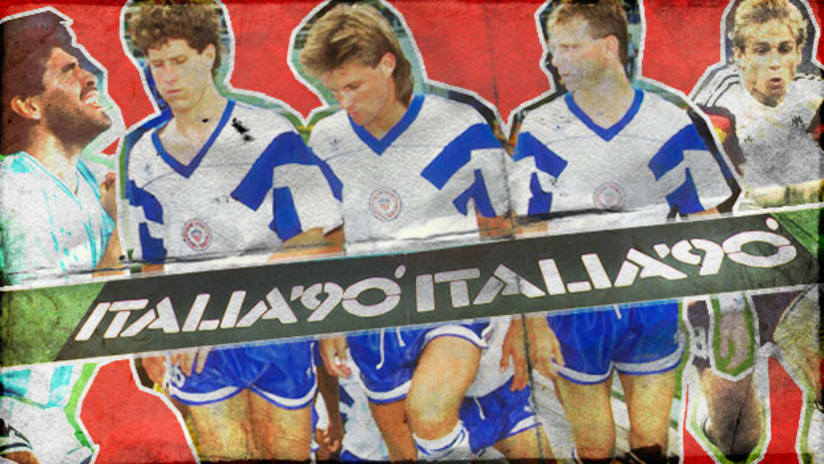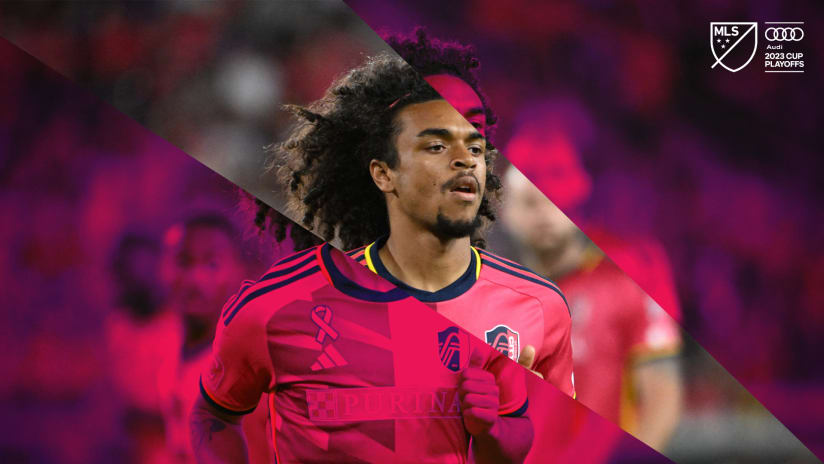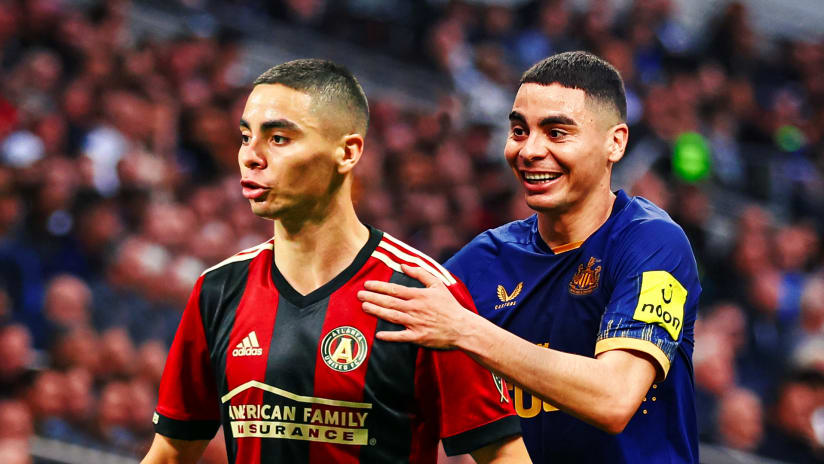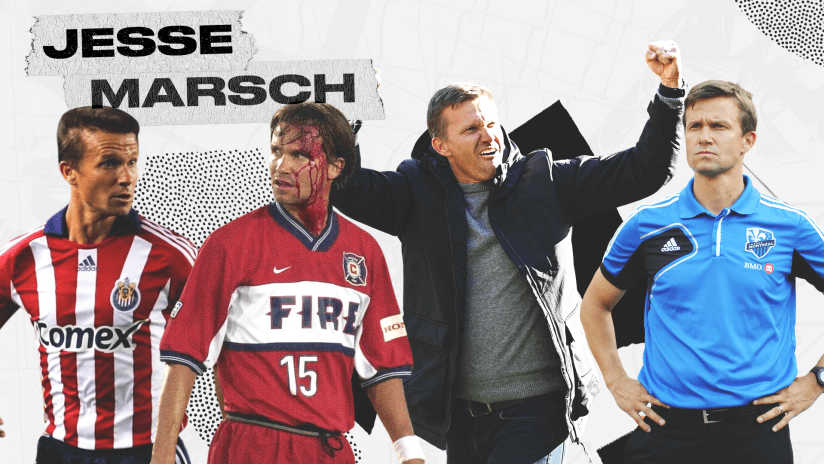THE WORD is MLSsoccer.com's regular long-form series focusing on the biggest topics and most intriguing personalities in North American soccer. This week, contributor John Bolster looks back at the origins of the US team that narrowly qualified for the 1990 World Cup, the country's first shot at the sport's biggest stage in 40 years. While they were decided underdogs throughout the tournament, the 1990 team's efforts in Italy paved the way for future generations of American soccer, and started a run of seven straight World Cup appearances for the US.
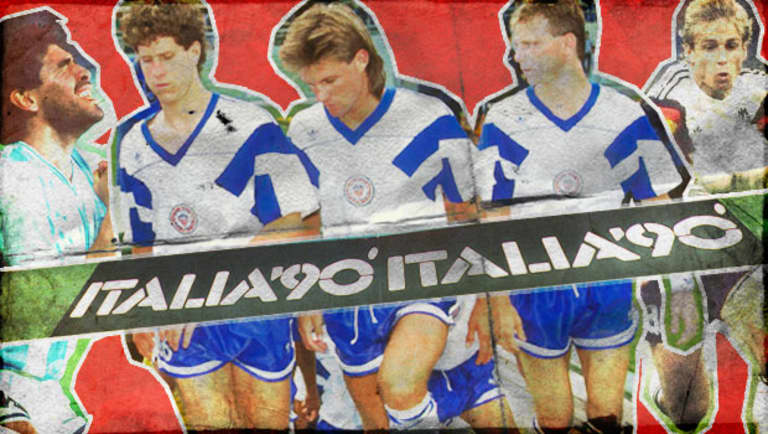
If you could line-graph the entire history of soccer in the United States and set it streaming across your screen, EKG-style, here’s what it would look like.
On the left-hand side, there’d be a burst of healthy-looking spikes from the early days, when the American Soccer League flourished as an international-caliber circuit in the 1920s and ’30s (really, you can look it up).
Next would come a long leveling-off period – the patient nearly flatlines several times – interrupted by a few widely spaced, upward jolts. There was Joe Gaetjens’ thunderbolt goal that upended England at the 1950 World Cup. Eighteen years later, the founding of the original North American Soccer League produces another spike. In 1975, the line would jump dramatically with the arrival of global icon Pelé, who injected the New York Cosmos, and by extension the NASL, with new life and a vibrant sense of possibility.
But not even the planet’s greatest player could permanently steady the game’s heart rate on these shores, and the NASL folded in 1984.
Five years later, though, on November 19, 1989, in Port of Spain, Trinidad and Tobago, a 25-year-old Californian named Paul Caligiuri pulled out the defibrillator paddles and with one lash of his left foot – clear! – reset the pulse of the game in this country.
It’s been beating steadily ever since.
This is the story of Caligiuri and his unassuming, unheralded, mullet-topped teammates on the 1990 US World Cup team, the guys who kept the top level of soccer alive in this country during one of its darkest periods. These are the guys who set the US game on its current course, which has included qualification in seven consecutive World Cups, a healthy, growing professional league, and a burgeoning pool of talent.
And like all underdog tales, this one almost didn’t happen.
–-
The US national team needed a win on the road in Port of Spain, Trinidad and Tobago, in November 1989 to secure their spot in the World Cup the next summer. Paul Caligiuri's goal in the 30th minute served as the game winner. (US Soccer)
–-
US Soccer was in relative disarray following the collapse of the NASL. The national team failed to reach the 1986 World Cup – the ninth straight time they’d missed out on the event, a run of futility stretching back to 1950 – and the 1990 qualifying campaign was in danger of going off the rails following a pair of scoreless draws against Guatemala and El Salvador, the last one at home against a Salvadoran side that had already been eliminated.
Those disappointing results meant that the Americans’ hopes of reaching the 1990 World Cup hinged on their final game, on the road against Trinidad and Tobago. If they won, they’d be the first US team in 40 years to qualify for the world’s biggest sporting event.
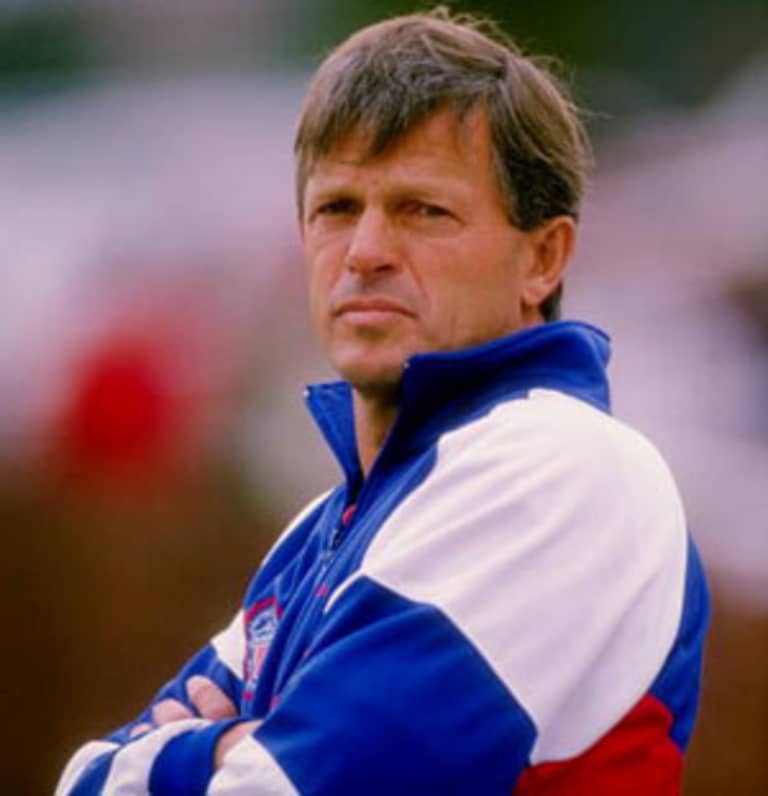
Hopes for the US team in 1989 were so low among American media members covering the team that one journalist asked head coach Bob Gansler (above), "How badly are you going to feel about the opportunity lost for American soccer?” (Getty Images)
Yet that wasn’t all that was at stake for the Yanks. In 1988, FIFA had awarded the right to host the 1994 World Cup to the United States, despite the nation’s tenuous tradition in the game and lack of a top-flight professional league. “Taking the World Cup to the United States,” one member of the competing Brazilian delegation told The New York Times, “is like taking the World Series to Brazil.”
Wary of such global skepticism, the United States Soccer Federation was keen to ensure that the USMNT qualified for Italia ’90 under their own steam, to legitimize their role as hosts in ’94, when they would qualify automatically.
Led by the late Werner Fricker, the federation put most of the USMNT players under contract, paying yearly salaries to play for the national side. Fricker chipped in a significant chunk of his own money, and the federation went into the red. As for the team, they met semi-regularly for training camps and friendlies, and otherwise cobbled together training sessions on their own, with their college teams, or with their teams from the rag-tag American Professional Soccer League.
- THE WORD: The 1994 World Cup hero who never was
So on November 19, 1989, in Port of Spain, the US players were battling for their dream of making a World Cup, as well as for their livelihoods (their USSF contracts were set to expire in December), and to lend much-needed credibility to USA 1994.
The unusually large (for the US) American media presence wasn’t exactly cheerleading, either. On the eve of the match, one American scribe asked US coach Bob Gansler, “After this game tomorrow, how badly are you going to feel about the opportunity lost for American soccer?”
On the other side of the ball, Trinidad and Tobago also had history in their sights: The Soca Warriors were looking to qualify for the World Cup for the first time ever – and they only needed a draw to pull it off
The government had declared a national holiday for the day after the game, and Port of Spain was “a sea of red,” according to US midfielder John Harkes. “In the stores, downtown, the marketplaces, around the corner, the gas station – everybody was in red.”
The stadium was packed beyond capacity, and the sprawling cricket ground outside the venue was also full, teeming with tens of thousands of red-clad fans, ready to watch the game on a big screen TV.
The match kicked off under the hot sun, and as US defender Steve Trittschuh remembers, “It was an ugly game. The field was terrible, the ball was bouncing all over the place.”
The decisive moment wouldn’t have happened if not for Caligiuri’s decision to flout coach Gansler’s instructions. Inserted at holding midfielder for that game – the only time in 110 US appearances that he lined up in that role – Caligiuri was supposed to man-mark T&T midfielder Russell Latapy and prevent him from getting the ball to future Manchester United star Dwight Yorke up top.
Caligiuri was specifically told not to attack, not to get forward.
In the 30th minute, though, frustrated by the US’s inability to generate any rhythm or create any chances, Caligiuri decided to “look for my one opportunity.” He picked up the ball in midfield, hoping to “start getting something going” for the US, he says. He wasn’t thinking about shooting.
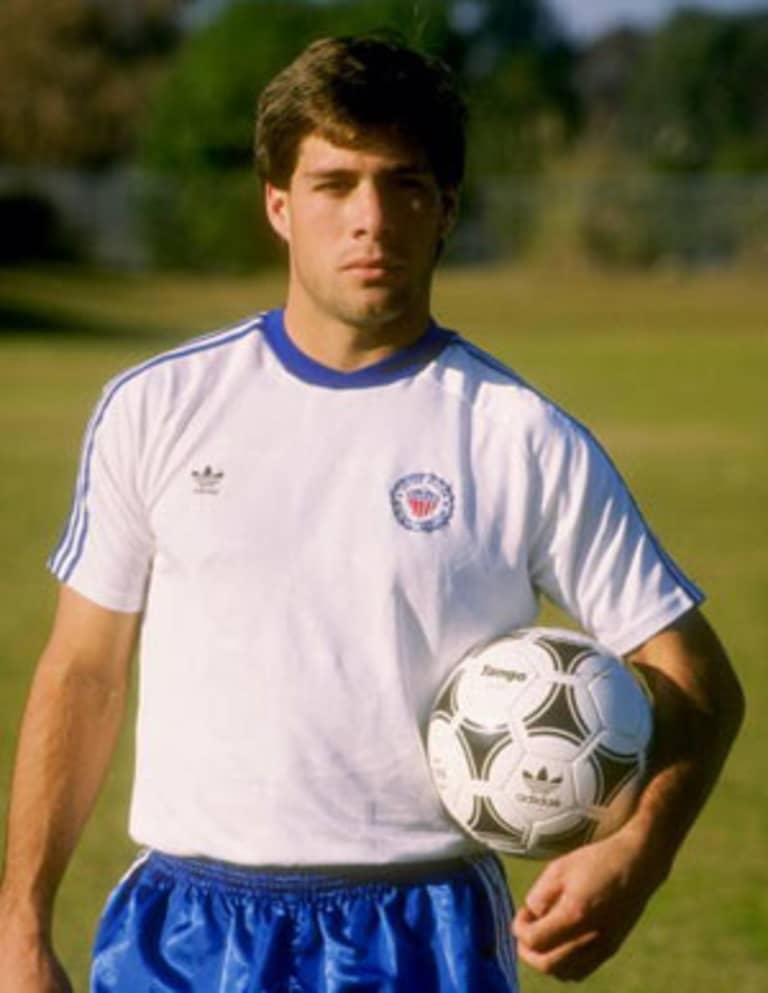
Paul Caligiuri ended scoring the game-winning goal of the US team's victory of Trinidad and Tobago, widely regarded as the biggest goal in US Soccer history. (Getty Images)
“I was thinking, I won’t lose the ball, coach," he says, "and, Don’t worry, we won’t get countered on.”
- MUSIC: Learn the new USMNT anthem
Then he looked up just as a T&T player rushed him, a little too fast.
“From there,” Caligiuri recalls, “it was just instinctive: fake, go to my left, and … maybe because I was in some sort of adrenalin rush of getting it forward, I took the shot without hesitation, didn’t think about it. Literally the moment I struck the ball, I knew it had a chance of going in.”
At the time, striker Bruce Murray told Soccer Week that he heard two T&T players nearby say, “Oh, God,” because they knew it was in.
Caligiuri was about 30 yards from goal, and his shot looped over the T&T 'keeper and found the back of the net, putting the Americans up 1-0.
But before the goal could stand up and take its place as "The Shot Heard ’Round the World," as US fans eventually dubbed it, there were some dicey moments – including late contact in the box between US defender John Doyle and Yorke that could have let Trinidad and Tobago off the hook.
“In today’s game, that’s a foul, for sure,” says Doyle, now the general manager of the San Jose Earthquakes, says. “But back in those days, you had to really crush somebody for it to be a penalty. There was good contact on that one, so I was happy it wasn’t a foul,” he says with a big laugh.
“If they’d gotten a penalty and we’d tied – I’ll tell you what, I would’ve been sick, that’s for sure. I’m not a real superstitious person, but somebody was looking out for me, I guess.”
–-
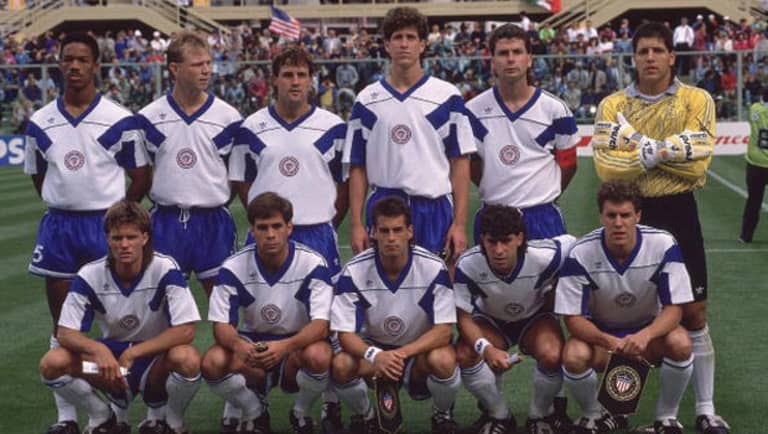
The US team before its first match of the 1990 World Cup, against Czechoslovakia. "The makeup of the group was not ‘happy to be there’ type guys," said forward Peter Vermes (bottom row, far right). "The makeup of the group was very much in line with seeing if we could sort of upset the apple cart." (Getty Images)
–-
Their historic, albeit skin-of-the-teeth qualification complete, what was the mindset of this patchwork group, heading into World Cup the following summer? They would face a formidable Czechoslovakia side, then the hosts and tournament favorites Italy, followed by a capable Austrian team.
Did they think they could nick a result here or there, and sneak into the second round, or were they just happy to be there to gain some valuable experience?
“We were all very excited to be there,” says Sporting Kansas City coach Peter Vermes, a striker on the ’90 squad. “But the makeup of the group was not ‘happy to be there’ type guys. The makeup of the group was very much in line with seeing if we could sort of upset the apple cart, if you will.”
Defender Jimmy Banks agrees, saying, “We knew it would be an uphill battle, but we were confident in our ability to compete. We had guys like John Harkes and Tab Ramos, who to me could play anywhere in the world if given the opportunity.”
Ramos, for his part, had a slightly different outlook.
“I think we were, in general, so naïve at the time, that we were just going to play the games,” he says. “I mean, we didn’t necessarily think we were going to lose the games. We were just going to compete, and sort of see what happens. I know personally – I can’t speak for all the guys on the team – but for me personally, I was in awe of the players that I was playing against. Here I was playing against guys that I used to see on TV. That for me was a treat.”
The treat became more of a trick right out of the gate, as the Americans faced Czechoslovakia in their opener on June 10. Czechoslovakia had sloughed off the constraints of Communism just one year earlier, and the tournament, was, in a sense, a coming-out party for the Czech side, a chance for them to audition for clubs in Europe.
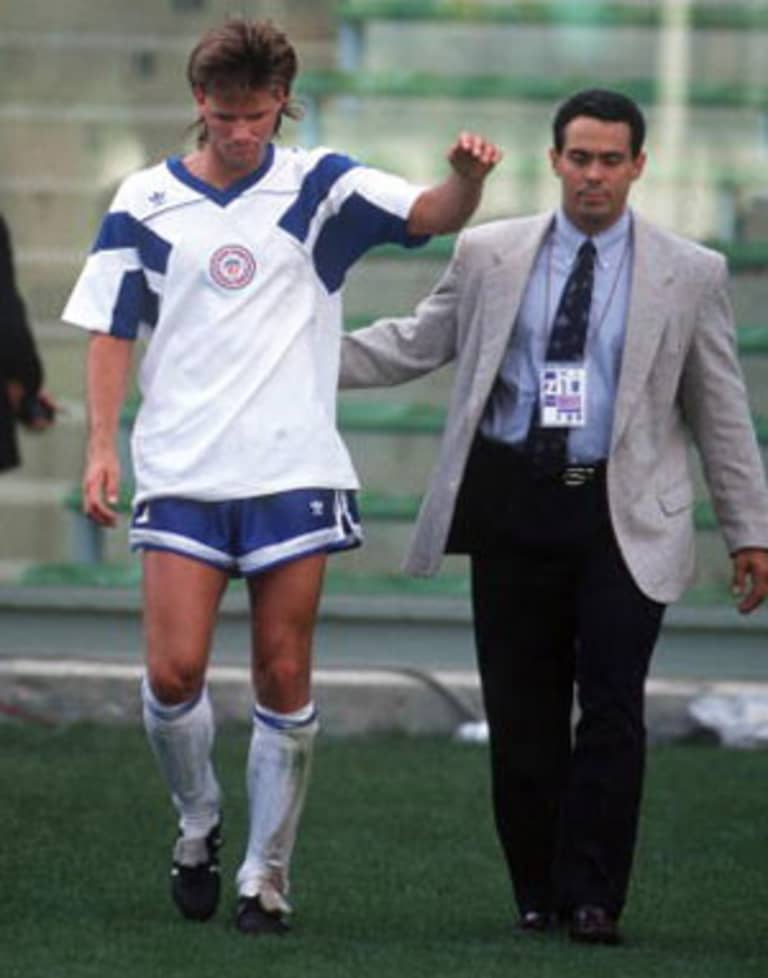
US forward Eric Wynalda is escorted off the field by a FIFA official after receiving a red card in the 52nd minute against Czechoslovakia. "I made up my mind that I was going to hurt somebody," Wynalda says, "and I did.” (Getty Images)
They had plenty of players who could ace those auditions, led by hulking striker Tomas Skuhravy, who went on to star at Genoa in Serie A. Behind Skuhravy, the Czechs lined up skillful midfielder Ivan Hasek, a Sparta Prague mainstay who jumped to RC Strasbourg after the World Cup.
Their backline featured Miroslav Kadlec, who signed with FC Kaiserslautern after the tournament and went on to win two Bundesliga titles, and Lubos Kubik, who had a distinguished career with Fiorentina, FC Metz, and Nuremberg before joining Major League Soccer and winning the 1998 championship with Bob Bradley’s Chicago Fire.
The US weren't quite prepared for the power, speed and skill of the Czechs.
“Our coaches had to dig in and pull up one or two obscure, kind of fuzzy, World Cup qualifying games [featuring Czechoslovakia],” says Harkes, “and we would look at that, and study it. But to go up against Skhuravy – we didn’t really know what we were up against.”
The US hung in for about a quarter of an hour and then were overwhelmed. Skuhravy opened the scoring in the 25th minute, Michal Bilek added a penalty in the 39th, and Hasek put the Czech’s up 3-0 just after the break.
Directly after Hasek’s goal, the situation went from bad to worse for the Yanks as Eric Wynalda – on the day after his 21st birthday – was goaded into a red-card offense in the 52nd minute. Skuhravy popped him in the face during a Czech corner kick.
- WORLD CUP MOMENTS: The legacy of US-Colombia in 1994
“That was the moment where I stopped playing soccer,” Wynalda recalls, “and I just went to war. I made up my mind that I was going to hurt somebody, and I did.”
He cracked Hasek in the jaw, and the referee did not hesitate.
“I deserved to get that red card,” Wynalda says. “It was embarrassing to be down 3-0 in the first game, and my mentality was, ‘I’m going down swinging.’ And that’s actually not the right way to do things.”
The US pulled a goal back nine minutes after the ejection – a beautiful strike by Caligiuri – but there would be no miracle comeback. Czechoslovakia pumped in two more goals to complete a 5-1 rout.
“Look, we had a huge challenge just playing 11-v-11," Vermes says. "Now, going down a man ..." he says before trailing off, his laugh saying it all: There was just no way.
–-
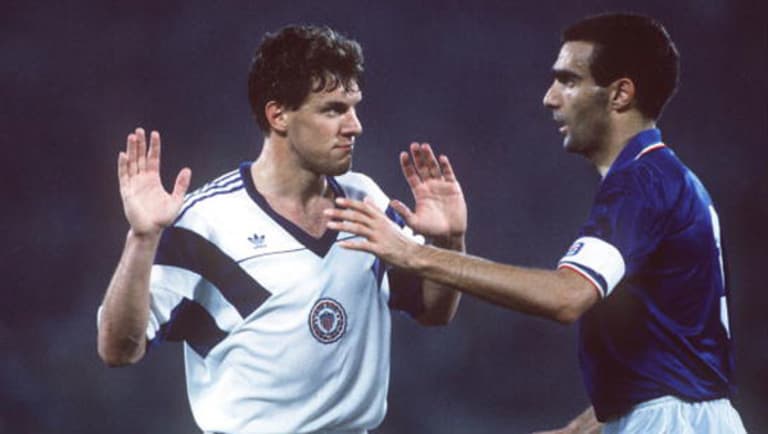
Italy's Guiseppe Bergomi confronts Vermes during the teams' matchup in Rome on June 14. The US eventually lost the game 1-0 and were eliminated from advancing past the group stage, but that was the day, Caligiuri says, "United States soccer grew up.” (Getty Images)
–-
Next up? Just a meeting with the hosts, in Rome, in front of a frenzied Olympic Stadium crowd of 73,423. Every single one of Italy’s players competed in Serie A, which Vermes notes “was the best league in the world at that time.”
The official US roster listed seven college players, two indoor players, and a number of guys playing in the two-year-old, not-top-flight APSL. The average age was 23. There were three players – Vermes, Christopher Sullivan, and Caligiuri – under contract overseas.
But hey, the team’s captain, Mike Windischmann, had a connection to Italy: He played for Brooklyn Italians – an amateur club in New York City.
There they were in the tunnel, Roberto Donadoni, Roberto Baggio and Walter Zenga, opposite Windischmann, Trittschuh, and Eichmann. It’s safe to say there was a drastic disparity in the lineups.
“I was playing at the University of San Francisco, Donadoni was playing at AC Milan," says Doyle. "Our entire payroll was one Italian player.”
And like the Czechs, the seasoned Italians were not above a little gamesmanship.
“Donadoni turns to me in the tunnel,” Doyle recalls, “and he says, ‘No, no, no, please you go, go.’ And I’m thinking, 'Man, these Italian guys are so polite. They’re letting us go first, out onto the field.' Of course, I had no idea.”
Donadoni’s gesture sent the Americans out alone to the whistles and jeers of the stadium packed with banks and banks of flag-waving Italians. When the Azzurri came out moments later, the place erupted in thunderous cheers.
“I was like, ‘Ohh, I get it,’” Doyle says. “Years later, when I saw Donadoni in MLS, I said, “Ohhh, that was a good one.’”
- WORLD CUP MEMORIES: On the bench for Donovan's goal in 2010
But the young and naïve Americans were steeled for battle this time. There would be no repeat of the Czech embarrassment.
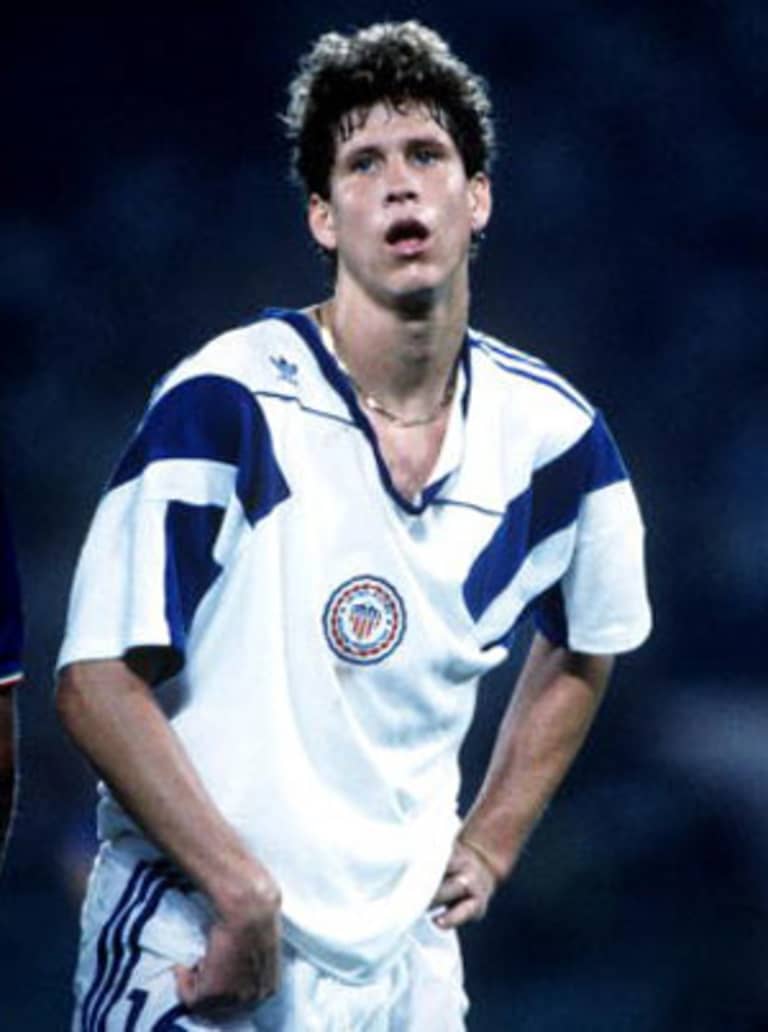
US forward Bruce Murray says the team's strategy against Italy was simple, and nearly effective: “Two banks of forward defending,and looking for that counterpunch. And we almost got it.” (Getty Images)
“We had seen the papers and headlines that hammered us,” says Harkes. “And during training [after the opening game] it was heated. We had really tense training sessions; there were bust-ups and pushing and shoving.”
Determined not to let the game open up, the US borrowed a little of Italy’s famed catenaccio, lining up in a more defensive posture.
“Two banks of forward defending,” recalls Murray, “and looking for that counterpunch. And we almost got it.”
After giving up a goal in the 11th minute, they almost did, and Murray was involved. In the 68th minute, he lined up a free kick about 25 yards out, and put a charge into it. Zenga barely kept it out of Italy’s goal, parrying the ball to the corner of the six, where Vermes charged it down and thumped another shot on goal. That one squirted through Zenga’s legs and rolled toward the goal line … where it was cleared away by an Italian defender.
Murray says he and Vermes often joked about how things might’ve been so much different if Vermes’ shot had found the net, but Vermes is philosophical about it these days.
“Honestly, the ball didn’t deserve to go in,” he says. “Because in the end they played better than we did. They had a lot more chances. We were surviving and hanging on in the game, but we truly didn’t deserve to tie them. But I will say that we saved face a little bit.”
Caligiuri remembers the Italian crowd cheering for the US after the final whistle, and points to the game as a milestone: “I’d have to mark that as the day that United States soccer grew up.”
The US had also gotten the attention of their next opponents, Austria, who came out pushing, shoving, and kicking in a game that had little more than pride at stake. (The US were out, Austria had an infinitesimal chance of advancing.)
“They just wanted to foul, and intimidate,” says Murray. “It was a terribly heated game.” The match report bears him out: Austria drew five yellow cards and one red, while the Yanks picked up four yellows.
Yet despite holding a man advantage for 56 minutes, they produced only one goal (by Murray) and lost 2-1, capping the country’s first World Cup appearance in nearly half a century.
–-
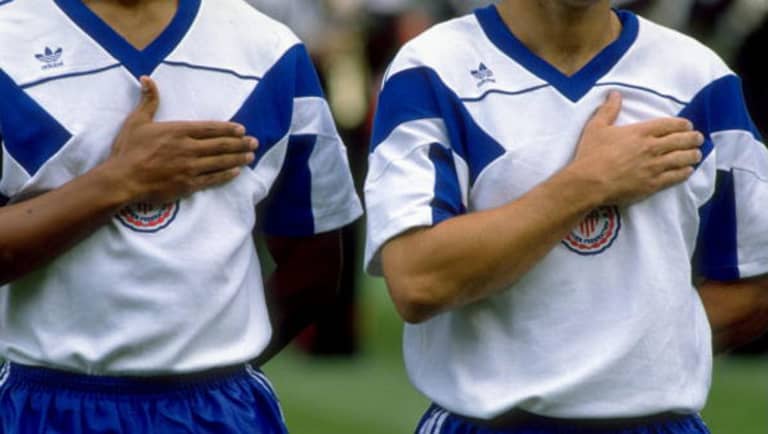
The US team lost all three matches of the 1990 World Cup, but 13 members of the team went on to play in Europe at some point in their careers. Six went on to suit up again at the 1994 World Cup in the United States. (Getty Images)
–-
The 1990 US side went three and out, and suffered a 5-1 trouncing, yet the performance, put in context, was better than it looks on paper.
Considering the experience levels of the players, the absence of a professional league, and the World Cup group they landed in, they fared reasonably well. Czechoslovakia reached the quarterfinals of the tournament, and the hosts Italy reached the semis, finishing third. Austria suited up some pedigreed players as well, including Toni Polster, who went on to score 79 goals in 151 appearances for FC Köln in the 1990s, and current USMNT assistant Andreas Herzog.
“Would we have like to have done better?” asks Doyle. “Yeah, for sure. Am I pleased with the results? No. But if you look back to where we were, and where the rest of the world was in soccer, the results were kind of to be expected.”
At one of the team’s first press conferences in Italy, coach Gansler was asked how many of his players could play in Europe at that moment.
“I said, ‘Given the opportunity, at least a half a dozen,’” Gansler recalls. “I can still hear the laughter in the room. But I think about 12 of them wound up playing in Europe, a little bit, and eight or 10 played substantially.”
If you count Tony Meola’s brief stint with Brighton & Hove Albion, 13 players from Gansler’s group made appearances in Europe, and Marcelo Balboa played two seasons in Mexico.
When he was assembling his roster, Gansler said, “the team we’re going to pick is one that will not only compete in 1990, but for the ’90s.” Sure enough, six players from the 1990 team appeared in USA ’94 (Kasey Keller was surprisingly left off by then coach Bora Milutinovic), and four turned out for the 1998 tournament.
Additionally, many of the 1990 players joined MLS sides when the league launched in 1996.
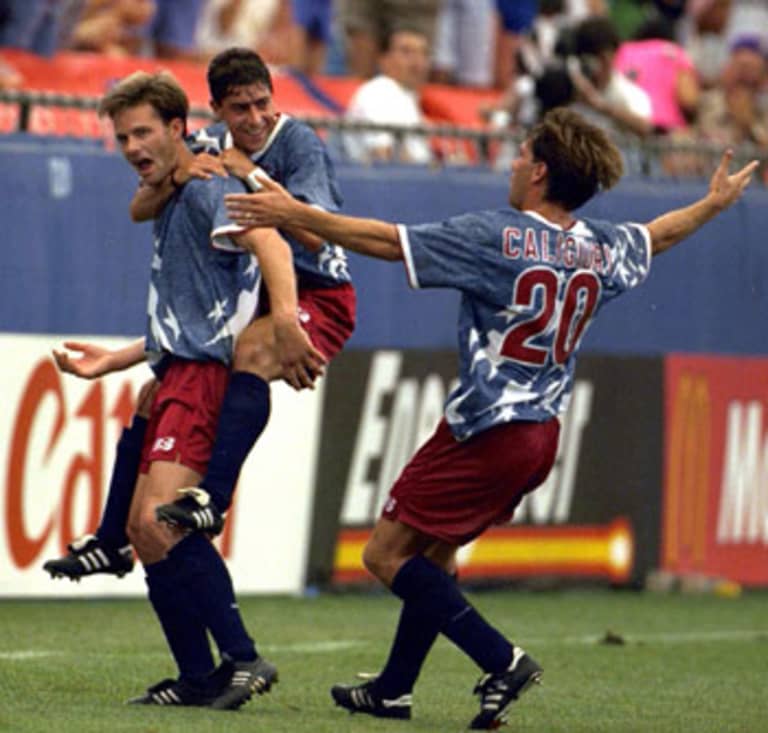
Wynalda (left) celebrates a goal during the 1994 World Cup with fellow '90 teammates Tab Ramos (center) and Caligiuri. "I guess we can look at ourselves as pioneers," says '90 defender Steve Trittschuh. "It’s kind of special, but like I said, a lot of people forget about it.” (Reuters)
“Everybody kind of forgets about the 1990 team,” says Trittschuh, “since the Internet wasn’t really around then, and there wasn’t a lot of press about it. But that’s [where] it all started. And if you look at a lot of those guys now, almost all of them are coaches, or GMs, or technical directors, within US soccer now. So I guess we can look at ourselves as pioneers. It’s kind of special, but like I said, a lot of people forget about it.
Ramos is the US Under-20 national team coach, US Soccer youth technical director and an assistant to USMNT coach Jurgen Klinsmann. Wynalda is a TV analyst as well as a coach for the Atlanta Silverbacks of the new NASL. Caligiuri has coached in the college ranks and now works with fabled youth club Irvine Strikers. Banks coaches youth ball as well as the Milwaukee School of Engineering men’s team. His son, JC Banks, plays for the USL PRO Rochester Rhinos.
Trittschuh is the coach of the USL PRO Colorado Springs Switchbacks, who begin play in 2015. Eichmann was an assistant with MLS’s Miami Fusion from 2000 to 2002, and now serves as director of coaching and player development for elite youth club Boca United.
“We were part of that first generation of American kids who actually grew up watching and playing soccer,” Eichmann says of the 1990 team. “We were a product of the North American Soccer League.
"I grew up in the Fort Lauderdale area, watching players like ‘Nene’ Cubillas and Gerd Müller with the Ft. Lauderdale Strikers. That’s really what fueled me – and I know a lot of the guys from the New York-New Jersey area – like John Harkes, Tab Ramos, Tony Meola, and Peter Vermes – grew up watching the Cosmos.”
The 1990 team, in turn, fueled the dreams of today’s national teamers.
- WORLD CUP: Complete coverage on MLSsoccer.com
“I had a poster of the 1990 team on my bedroom wall,” US 'keeper Tim Howard once told ESPN. “And I wanted to do exactly what Tony Meola did.”
The 1990 squad set the tone for grassroots passion for the sport in this country.
“It was a difficult time frame, and we were fighting, fighting for our lives as a sport, and fighting for our livelihoods,” says Eichmann. “Trying to do whatever we could to stay sharp, to develop, keep playing, and promote the game, and hope that the game did succeed. There was no guarantee back then that the game would ever make it on the professional level.
"The only thing that would keep you going through that period was your love for the game, and the passion. None of us were going to let that go. We were going to play and do whatever it took to continue doing what we really loved to do.”
With Gansler and his staff, and backed by Werner Fricker, the ’90 team got to where they and US Soccer needed to go. They didn’t shock the world in Italy, but there were genuine signs of hope amid the three losses – you just had to be willing to see them.
Before the game against Italy, Wynalda was standing in the middle of the magnificent Olympic Stadium pitch, dejected that he wouldn’t be taking part because of his red card in the opener. Gansler happened by and asked if he was OK. The player responded glumly that he was. Gansler assured him better days lay ahead.
“I said, ‘Well, I hope so,’” Wynalda recounts. “I had been ready to give up, cry, I don’t know what the hell. And he says, ‘No, no, listen,’ and he looked at me and he put both hands on my shoulders, looked right in my eyes, and said, ‘You’re gonna have much, much better days.’"

